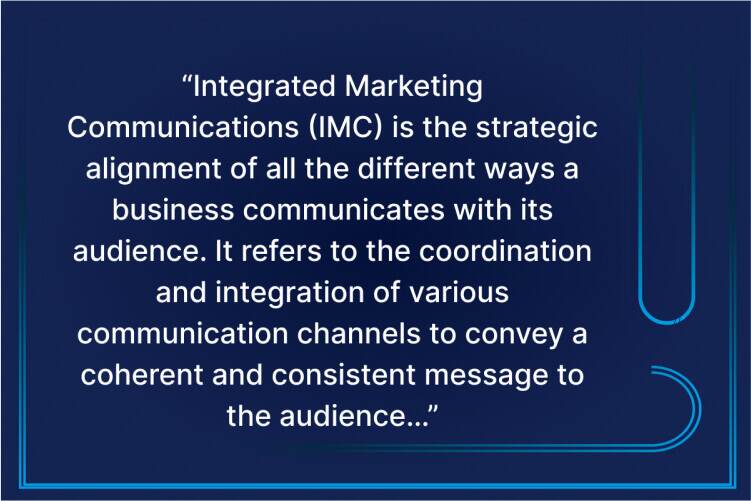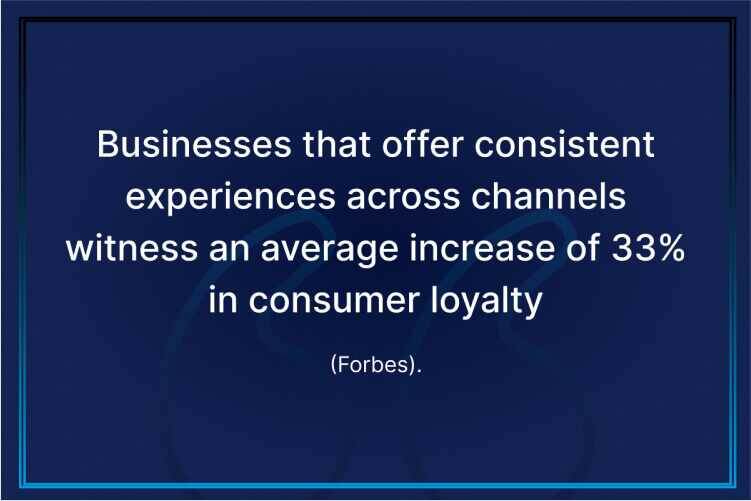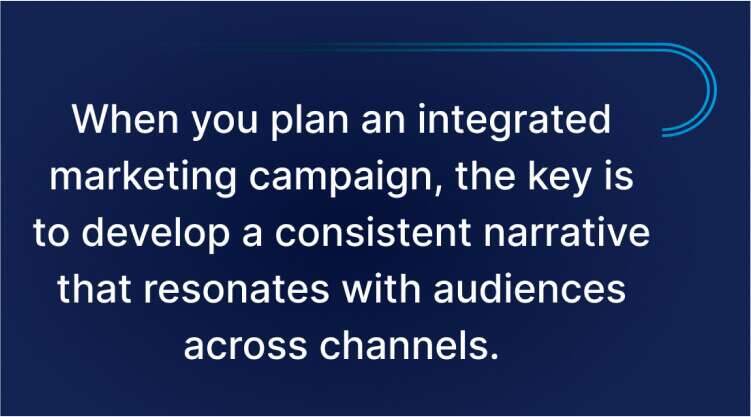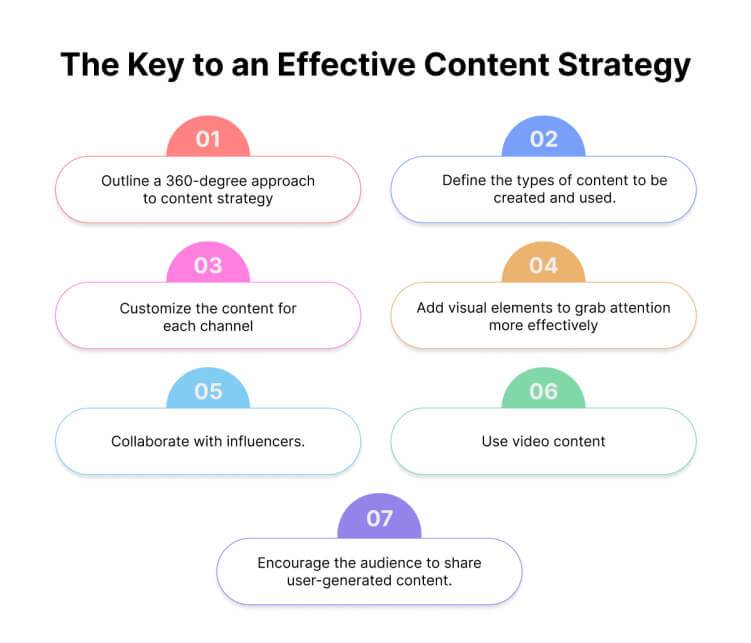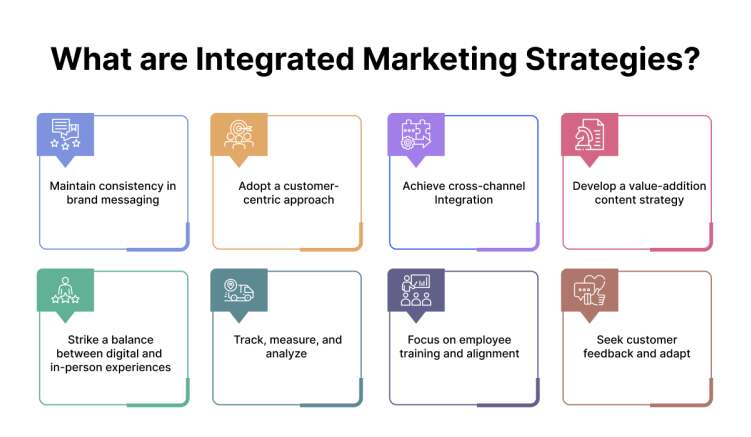If your business is able to convey a consistent and cohesive message across all channels and touchpoints, it means your marketing communication is integrated.
However, for many companies, maintaining an integrated approach to marketing communication is a big challenge as there are so many channels and mediums around.
When there is a lack of integration with marketing communications, it becomes tough to reinforce brand identity and value. Then, customers will have a hard time recognizing and remembering the brand.
So, how can your business deliver a seamless and unified experience to customers across channels and platforms?
This is where integrated marketing communications can help!
It will help your business make the messages consistent and synchronized across different channels so that customers have a more enriching interaction with the brand.
In this blog, we will explore in detail what integrated marketing communications (IMC) is, how to execute IMC campaigns, examples, and IMC strategies.
But first, let’s get started with understanding what IMC stands for…
What is Integrated Marketing Communications?
Integrated Marketing Communications (IMC) is the strategic alignment of all the different ways a business communicates with its audience. It refers to the coordination and integration of various communication channels to convey a coherent and consistent message to the audience.
The purpose of adopting IMC is to ensure that all aspects of marketing communication – whether online or offline – work together in harmony and help deliver a seamless experience for customers.
With this kind of unified approach to marketing communications, a business will be able to enhance brand visibility and create a more rewarding connection with the audience.
Why is Integrated Marketing Communications Important?
Integrated marketing communications have a key role in creating a customer-centric marketing strategy. It helps businesses in devising unified and impactful messaging, resulting in improved brand visibility and engagement.
There are several reasons why marketing communications work best when they are integrated, including –
- Adopting integrated communications in marketing can help your business maintain consistency in brand messaging which makes it easier for customers to understand the brand better.
- Your business can create a more positive and memorable experience for customers by ensuring a consistent message at every stage of their journey or at every touchpoint. This can result in improved satisfaction and engagement.
- The purpose of integrated marketing is to reinforce messages through multiple channels so that a better brand recall value can be generated.
- Your business can avoid the resources and efforts that often go into creating separate campaigns for different channels and rather save a lot with a unified strategy.
- IMC makes it possible to tailor messages based on the specific behaviors and preferences of the customer segment, resulting in better response rates.
- Having an IMC plan is key to maintaining synergy between channels that yield a higher ROI and generate better results.
- An integrated marketing approach brings the opportunity to adapt to market trends and tech advancements, and successfully respond to new challenges in terms of evolving consumer behavior.
- IMC ensures a holistic approach to marketing communications with an enhanced focus on each channel of customer preference.
How to Build an Integrated Marketing Campaign?
The purpose of building an integrated marketing campaign is to deliver a unified message to your audience across channels. To achieve that target, you need careful planning and execution of your campaign across channels with coordination and adaptability for each channel.
Here is a step-by-step guide to building an integrated marketing campaign –
1. Define Your Campaign Goals
Defining your campaign goals will offer a clear roadmap for your integrated marketing efforts. It will guide your decision in every aspect, from channel selection to content creation, and ensure that your campaign is in alignment with the goals.
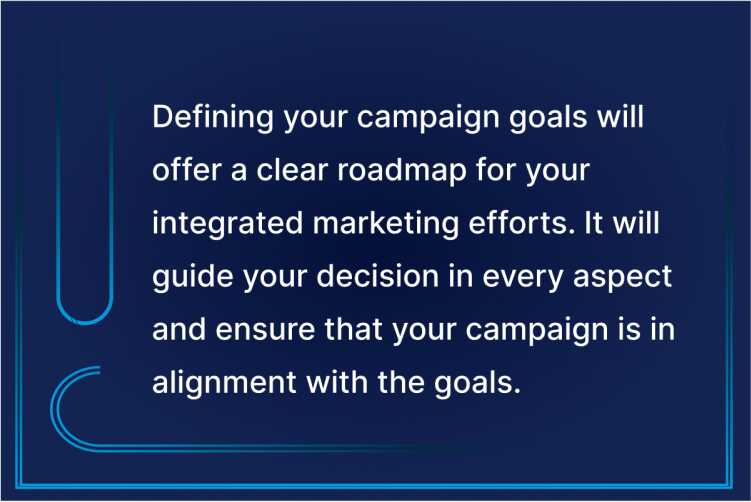
Key Features
- Be clear about the goals such as whether you want to drive sales, boost brand awareness, grow website traffic, or improve engagement.
- Break down your goals into measurable objectives using the SMART framework.
- Do audience segmentation to clearly understand whom your campaign will target as that will help you be effective with messaging and tactics.
- Set and define the campaign value proposition that you aim for the audience.
- Set the budget for the campaign and never forget to track and measure the KPIs of your IMC plan.
2. Identity Your Target Audience
Identifying your target audience is the next vital step in building an IMC strategy for your business. All your key decisions will hinge on this step whether they are related to the selection of channels, types of messaging, and tactics. More importantly, knowing the audience can help you tailor the campaign to resonate with the people who are most likely to be your potential customers.
Key Features
- Create a broad profile of your target audience by understanding their basic demographic traits such as age, location, gender, income, and job.
- Leverage the psychographic factors and try to understand what motivates your audience, what are their interests, hobbies, attitudes, and values.
- Identify the problems and needs of your audience and see how your products can fit well in solving their pain points.
- Do a competitor analysis to find if is there any segment being neglected by others that you could focus on and capitalize on the gaps therein.
3. Create a Unified Message
When you plan an integrated marketing campaign, the key is to develop a consistent narrative that resonates with audiences across channels. If the message lacks consistency, your target audience might feel confused about your brand’s core values and unique value proposition. So, it’s important to stay consistent with your brand’s essence and let every channel delivers uniform messages to the audience.
Key Features
- Adopt a personalized approach to messaging so that your brand campaign can speak directly to the aspirations of the target audience.
- Use storytelling elements to connect with the audience on a personal level.
- Ensure consistency in tone, language, and emphasis of your messages across channels.
- Add visual elements to make the messages more memorable for the audience.
4. Choose Channels and Tactics
Devising a memorable and impactful integrated marketing campaign is not possible unless you choose the right channels and tactics. Since each channel comes with a unique reach and audience profile, you need to consider the business needs and strike the right balance between the offline and online channels. To get value with channel selection, make sure you have a clear understanding of the audience and their preferred channels.
Key Features
- Use multiple channels for devising and delivering a cohesive brand experience.
- Analyze each channel separately and focus on including only those, whether online or offline, that align with your business goals and customer needs.
- Make sure your unified message is run across channels on a regular basis.
5. Develop a Robust Content Strategy
The success of an integrated marketing campaign will depend on the quality of content and creative assets. The key is to tailor the content to each platform and make sure a consistent message is spread across channels. This is how a campaign will resonate with the audience across various platforms and channels. Another important thing to remember is that the campaign message should be aligned with the target audience’s needs. After all, more than 70% of marketers use content as part of their marketing strategy.
Key Features
- Outline a 360-degree approach to content strategy and define the types of content to be created and used.
- Customize the content for each channel and add visual elements to grab attention more effectively.
- Collaborate with influencers.
- Use video content and encourage the audience to share user-generated content.
6. Plan the Campaign Schedule
It’s important to create a detailed campaign schedule that outlines when each element will be executed. With a well-planned and well-structured timeline, it becomes easy to coordinate and launch the campaign at the right time. This will also ensure the tasks are finished on time and the team stays motivated.
Key Features
- Establish the duration of your marketing campaign.
- Set deadlines for specific activities.
- Make sure you have done channel-specific planning with sufficient time for proper execution.
- Consider delays and changes and build some buffer time.
7. Allocate Budget and Resources
A proper allocation of budget is essential for executing your campaign effectively. When there is requisite financial support, everything goes smoothly and no major hiccups are faced along the way. It however takes careful planning and a good understanding of the campaign needs to allocate the budget.
Key Features
- Set a clear and realistic budget for your campaign.
- Take into account all the costs with different elements.
- Give preference to channels when you allocate the budget.
- Never compromise on the key aspects as an integrated marketing campaign needs an adequate budget to succeed.
8. Use Integrated Marketing Communication Tools
A business that adopts integrated marketing communications (IMC) must use a combination of tools and channels to deliver a unified message to the target audience. The choice of tools will depend on the marketing goals and target audience your business looks to cater to. More so, the integrated marketing communication tools you use should be tailored to the specific goals of your marketing. When you have a well-integrated mix of these tools, you can surely make your marketing communication more effective than ever.
What are Integrated Marketing Strategies?
Integrated marketing communications process can help a business make all the marketing efforts works together in sync to convey a consistent brand message. It involves various strategies where businesses need to maintain coordination among various marketing tactics and channels for delivering a unified brand message.
Here are some integrated marketing strategies that a business should use –
Maintain consistency in brand messaging
The real goal of integrated marketing is to achieve consistency in brand image and messaging across channels and marketing materials. To achieve this goal, it’s important to maintain uniformity in materials and messages so that brand identity and core values resonate with the target audience.
Adopt a customer-centric approach
The real purpose of an integrated marketing communications plan is lost when the marketing efforts fail to address the specific needs of the target audience. After all, effective communication should be in tune with the preferences and behavior of the audience. So, your business should focus on creating personalized messages and experiences that connect with the audience on a more personal level.
Achieve cross-channel Integration
Your target audience is not limited to one specific channel. Rather they are distributed across platforms. So you need to focus on using multiple channels to reach your audience. More importantly, there needs to be an integration between different channels so that your message is consistent wherever it’s received by customers.
Develop a value-addition content strategy
The content you create for marketing should serve three broad purposes – educate, engage, and entertain. All this can be achieved only when you produce relevant and valuable content across channels. If the content is value-driven and created to solve customers’ problems, it then becomes easy to reinforce your brand’s message.
Strike a balance between digital and in-person experiences
One of the key aspects of integrated marketing strategies is to strike a fine balance between digital and in-person experiences for customers. For better digital experiences, you can leverage the power of social media, email marketing, SEO, and paid ads. For creating memorable in-person experiences, you can use events, product demos, and workshops.
Track, measure, and analyze
Running integrated marketing campaigns is as important as tracking and measuring their performance across channels. This will help bring tons of useful data that you can use to refine your strategy. With regular tracking of the performance, you can enhance the allocation of resources and positively impact the success of marketing efforts. Plus, when you use five or more tools for analytics, you’re 39% more likely to improve your marketing performance.
Focus on employee training and alignment
If your employees are not properly trained, no matter how much effort you put into marketing, the results will always be below par. For that reason, you should invest in employee training so that everyone in the organization is on the same page in terms of communicating your brand message. When the team is trained, it will help consistently communicate the brand’s ethos and values.
Seek customer feedback and adapt
Customer feedback is important whether you want to improve marketing, sales, or support. The key is to listen to customers attentively across channels, gather feedback, and then implement the changes to your communication strategies. This will make your IMC more effective and also let you come across a brand that is responsive to customer needs.
Benefits of Integrated Marketing Communications
Integrated marketing communications is a coordinated marketing approach that helps businesses convey a consistent message to target audiences. It combines various channels and elements and offers a range of benefits that ensure the effectiveness of a marketing strategy.
Here are some of the benefits of integrated marketing communications –
- Businesses that adopt an integrated marketing communications plan can convey a unified message by maintaining consistency across platforms.
- Implementing an integrated approach builds trust among consumers as they can see unified messages across channels and perceive the brand as reliable.
- Cost savings and improved efficiency are often the result when a business adopts an IMC approach as then its marketing efforts become coordinated which saves efforts and resources.
- A business that uses integrated marketing communications process engage customers more effectively through consistency in efforts and this helps them gain increased customer loyalty.
- IMC is a cohesive marketing strategy where the impact of efforts is greater leading to a better return on investment for the business.
- When the marketing communications are integrated, it ensures a consistent brand experience across various touchpoints.
- Running a unified marketing campaign can offer a competitive advantage as it makes messaging more memorable.
Examples of Integrated Marketing Communications
Nike’s “Just Do It” Campaign
Nike is a great example of how to keep your marketing communications integrated and deliver a seamless experience to customers across channels. The way it maintains consistency with the legendary “Just Do It” slogan and ensures uniformity of messaging across different channels is exemplary. For the slogan campaign, the company consistently uses TV ads, print ads, social media posts, and videos apart from collaborating with influencers. All this helps in the delivery of a cohesive message everywhere.
Apple’s Product Launches
Apple knows how to launch new products and make big announcements in style. Its launch campaigns are famous for their integrated approach. When Apple launches a new product, it creates buzz through teaser videos, online banners, and email campaigns. More so, it live streams the launch event and uses social media to generate excitement. In addition, Apple follows that with ads and blog posts to make sure the message is well-received across multiple touchpoints.
Red Bull’s Extreme Sports Sponsorships
Red Bull is a brand that takes the concept of integrated marketing communications to the next level. Its USP lies in consistently sponsoring extreme sports and adrenaline-pumping events with athletes tied into the marketing strategy. Most of the exciting videos and documentaries they create and share are well-received across social platforms. More so, they keep hosting their own events all through the year with the common theme of energy and adventure being prompted across channels. .
Starbucks’ Rewards Program
No brand can match the creativity and innovativeness of Starbucks when it comes to running reward programs and keeping customers hooked. The company integrates the reward programs across various channels. It keeps sending personalized emails and notifications that inform users about reward points. More so, it regularly does in-store promotions of reward programs and all this helps customers feel engaged and do repeat visits.
Integrate Your Marketing Communications With REVE Chat Tools
Integration is key to achieving the best results with your marketing communications. We, at REVE Chat, understand the importance of supporting your marketing efforts with the right tools and technology and ensuring value for customers at each stage of their journey.
With us, you find a wide range of engagement tools that can add value to various facets of your marketing communication.
Your business can use our AI-powered chatbot to automate various facets of marketing. Further, our video chat software and co-browsing software are very helpful in offering visual engagement which can contribute to the efficiency of your marketing engagement with customers.
We have live chat software that can be added to the chatbot to offer hybrid support and ensure of best experiences for customers across channels.
Final Thoughts
The success of your marketing communication hinges on the efficiency of integration. The more integrated the communication, the better overall marketing impact it will have for your business.
We, at REVE Chat, understand the role of technology in supporting your integrated approach to marketing communication. So, we have a range of useful tools that can add great value to your marketing efforts.
You can sign up and start checking our tools and see how they can contribute to the growth of your business.

